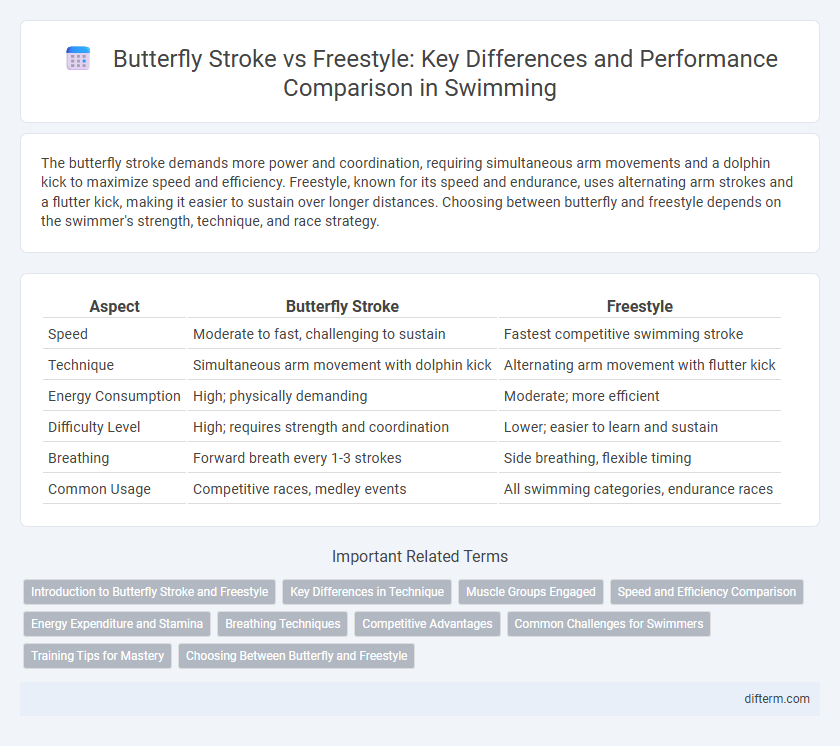The butterfly stroke demands more power and coordination, requiring simultaneous arm movements and a dolphin kick to maximize speed and efficiency. Freestyle, known for its speed and endurance, uses alternating arm strokes and a flutter kick, making it easier to sustain over longer distances. Choosing between butterfly and freestyle depends on the swimmer's strength, technique, and race strategy.
Table of Comparison
| Aspect | Butterfly Stroke | Freestyle |
|---|---|---|
| Speed | Moderate to fast, challenging to sustain | Fastest competitive swimming stroke |
| Technique | Simultaneous arm movement with dolphin kick | Alternating arm movement with flutter kick |
| Energy Consumption | High; physically demanding | Moderate; more efficient |
| Difficulty Level | High; requires strength and coordination | Lower; easier to learn and sustain |
| Breathing | Forward breath every 1-3 strokes | Side breathing, flexible timing |
| Common Usage | Competitive races, medley events | All swimming categories, endurance races |
Introduction to Butterfly Stroke and Freestyle
The butterfly stroke is characterized by simultaneous arm movements combined with a dolphin kick, requiring significant strength and timing for efficient propulsion. In contrast, freestyle, often referred to as the front crawl, emphasizes alternating arm motions and a flutter kick, enabling faster speed and endurance. Both strokes demand distinct techniques and muscle coordination, influencing swimmer performance in competitive events.
Key Differences in Technique
The butterfly stroke relies on a simultaneous, symmetrical arm movement combined with a powerful dolphin kick, while freestyle uses alternating arm strokes and a flutter kick for propulsion. In butterfly, the swimmer's body undulates in a wave-like motion, requiring significant core strength and timing, whereas freestyle emphasizes continuous, smooth rotation of the torso for efficiency. Breathing in butterfly occurs during the arm recovery phase with the head lifting forward, contrasting with freestyle's side breathing pattern that minimizes drag.
Muscle Groups Engaged
The butterfly stroke primarily engages the latissimus dorsi, deltoids, pectorals, and core muscles, demanding explosive upper body strength and coordination. Freestyle targets the deltoids, triceps, latissimus dorsi, and lower body muscles such as the quadriceps and hamstrings, emphasizing endurance and continuous propulsion. Both strokes require strong core activation for stability, but the butterfly's simultaneous arm movement intensifies muscular engagement compared to freestyle's alternating arm motion.
Speed and Efficiency Comparison
Freestyle stroke outpaces the butterfly in speed, with elite swimmers reaching speeds up to 5.1 mph compared to butterfly's 4.7 mph. Freestyle's alternating arm movement and streamlined body position promote greater efficiency, reducing drag and conserving energy during races. Butterfly stroke demands higher muscular strength and coordination, resulting in faster fatigue despite its powerful propulsion.
Energy Expenditure and Stamina
The butterfly stroke demands significantly higher energy expenditure due to its simultaneous arm movement and strong dolphin kick, engaging more muscle groups than freestyle. Freestyle conserves stamina more effectively by alternating arm movements and utilizing a more rhythmic breathing pattern, allowing swimmers to maintain speed over longer distances. Efficient energy management in butterfly requires advanced technique and endurance training to minimize fatigue and maximize stroke power.
Breathing Techniques
Breathing techniques in butterfly stroke involve simultaneous inhale above water during the arm recovery phase, demanding precise timing to maintain rhythm and reduce drag. Freestyle swimmers employ bilateral or unilateral breathing patterns, rotating the head sideways to inhale, which enhances oxygen intake while sustaining streamline body position. Mastering these distinct breathing methods is crucial for optimizing stroke efficiency and endurance in competitive swimming.
Competitive Advantages
The butterfly stroke provides competitive advantages through its powerful and symmetrical arm movements, generating strong propulsion and enabling faster acceleration in short-distance races. Freestyle offers greater versatility and energy efficiency, allowing swimmers to sustain higher speeds over longer distances with reduced fatigue. Mastery of the butterfly stroke often leads to superior burst speed, while freestyle remains dominant in endurance events due to optimal oxygen consumption and streamlined body positioning.
Common Challenges for Swimmers
Swimmers often face common challenges such as maintaining proper breathing rhythm and body position in both butterfly stroke and freestyle. The butterfly stroke demands precise timing and significant upper-body strength to execute simultaneous arm movements, while freestyle requires efficient rotation and continuous propulsion to optimize speed. Both strokes require consistent training to overcome fatigue and improve stroke efficiency in competitive swimming.
Training Tips for Mastery
Mastering the butterfly stroke requires focused strength training on the shoulders, core, and hip flexors to sustain powerful and rhythmic dolphin kicks. For freestyle, emphasize endurance and efficient breathing techniques to maintain speed and minimize drag over long distances. Combining interval sets targeting stroke rate and breathing control enhances overall swim efficiency across both strokes.
Choosing Between Butterfly and Freestyle
Choosing between butterfly and freestyle depends on a swimmer's skill level and training goals, as butterfly demands more strength, coordination, and technique, making it ideal for advanced athletes seeking muscle endurance and power. Freestyle offers greater speed and efficiency with a simpler technique, suitable for beginners or those aiming for long-distance performance and aerobic conditioning. Understanding personal fitness objectives and stroke mechanics helps optimize swimming training and competition results.
butterfly stroke vs freestyle Infographic

 difterm.com
difterm.com